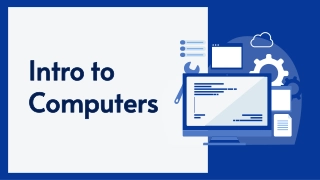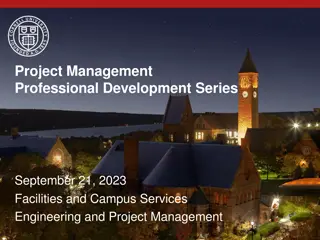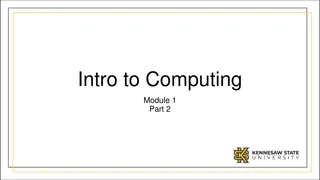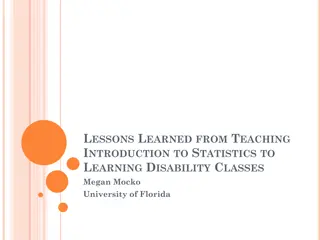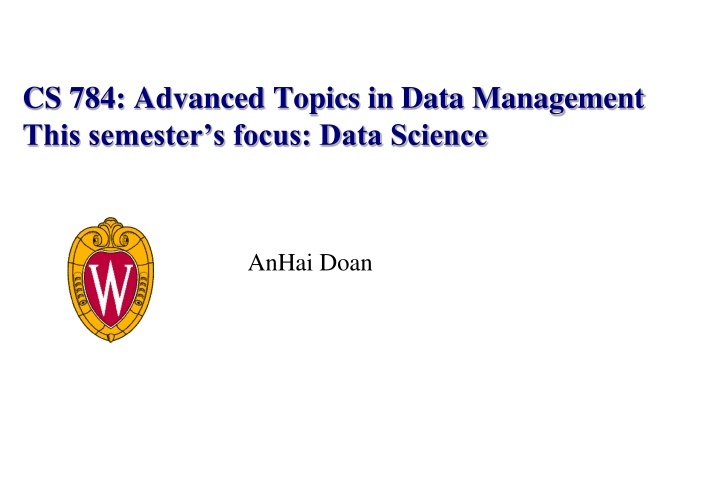
Advanced Topics in Data Management: Data Science Insights
Explore the fascinating world of data science, from defining it to its practical applications in various industries. Discover the key components, skills required, and the motivation behind the rise of data science.
Download Presentation

Please find below an Image/Link to download the presentation.
The content on the website is provided AS IS for your information and personal use only. It may not be sold, licensed, or shared on other websites without obtaining consent from the author. If you encounter any issues during the download, it is possible that the publisher has removed the file from their server.
You are allowed to download the files provided on this website for personal or commercial use, subject to the condition that they are used lawfully. All files are the property of their respective owners.
The content on the website is provided AS IS for your information and personal use only. It may not be sold, licensed, or shared on other websites without obtaining consent from the author.
E N D
Presentation Transcript
CS 784: Advanced Topics in Data Management This semester s focus: Data Science AnHai Doan
What We Will Discuss Logistic course enrollment no class this Friday What is data science? Motivation, the rise of data science What CS at UW-Madison is doing about it What will be covered in this class, goals of the class Course syllabus Next step 2
Data Science No one really knows what it is There is a popular joke about this A very common definition data science focuses on extracting (actionable) insights/knowledge from data This does not really capture all DS activities in the wild 3
Data Science Tasks extract insights from data = performing analysis build data-driven artifacts: knowledge bases, rec systems, design data-driven experiments to answer a question Need to know database management (RDBMSs), machine learning, AI, data mining managing different kinds of data (relational, text, Web, graph, time series, etc) statistics optimization, linear algebra visualization big data systems distributed/parallel systems, networking security/privacy Skills Python/R data science eco systems Big data systems: Hadoop, Spark, NoSQL SQL 4
How is DS Different From RDBMSs data mining statistics Big Data 5
Motivation / The Rise of Data Science RDBMSs transactional data management, belong to the CIO Web => Google, other Web companies Three trends much easier to generate and capture data much easier to process data (eg on the cloud) many more people become involved Lead to Big Data change in perception: data is now at the heart of enterprises lot of data, how to process it? => big data systems how to store/query it? => NoSQL databases how to get value out of it? => data analytics, data science 6
Examples Johnson Control WalmartLabs product catalog product matching Non-profit organizations database My house My car GE and the Internet of Things Google Knowledge Graph AB testing Everything is increasingly data driven 7
What CS @ UW-Madison Is Doing About This? Data science is very hot today (sexiest job of the century, etc.) pays very well out there, many bootcamps What we think we have seen fads come and gone is this a fad? it s likely that it will stay the fundamental fact is that everything is increasingly data driven (electricity, digital, online) so a lot of people and skills are needed to process data so even if the name data science disappears, the fundamental problem will remain Our current plan design a sequence of DS courses for grad students: 784, 838, design a sequence of DS courses for ugrads (eventually opening up to the entire UW) design DS plans for the db group, CS dept, and UW-Madison many universities are doing the same thing your ideas? What do you want to see? 8
Coverage and Goals of this Class Tasks extract insights from data = performing analysis build data-driven artifacts: knowledge bases, rec systems, design data-driven experiments to answer a question Need to know database management (RDBMSs), machine learning, AI, data mining managing different kinds of data (relational, text, Web, graph, time series, etc) statistics optimization, linear algebra visualization big data systems distributed/parallel systems, networking security/privacy Skills Python/R data science eco systems Big data systems: Hadoop, Spark, NoSQL SQL 9
Coverage and Goals of this Class Tasks extract insights from data = performing analysis main focus of this class let s illustrate this using an example 10
Example Company has multiple departments Depts interact with customers Boss wants to know how are customer complaints distributed across depts? are there any interesting patterns regarding customer complaints? can we predict anything regarding customer complaints and can we take any action? You the data scientist start by collecting data Emps(eid, name, phone, address, did) Depts(did, name) Complaints(cid, cname, ename, phone, dname, date, desc) Services(sid, date, desc) Subsequent steps data extraction data understanding, cleaning, transformation data integration (most likely) data understanding, cleaning, transformation again data analysis 11
Example You will most likely do two stages development production Using a data analysis stack and a big data stack 12
Course Syllabus Big picture RDBMS, machine learning, crowdsourcing, big data systems Extracting insights from data Data acquisition, data lake The development stage Data extraction: from HTML pages, from text Data understanding, cleaning, transforming Data integration: matching schemas, matching entities Data exploration/analysis The production stage Building artifacts Designing data-intensive experiments to answer questions Misc managing different kinds of data: text, Web, social media 13
Misc Issues Reading and lecture notes Project 14


